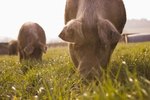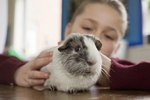
Taking care of a show pig and raising it until show day is a big responsibility. It requires some basic equipment, but not as much as raising some other types of livestock. If money's an issue, you can pick up some items secondhand, such as buckets or feeders. Don't skimp on feed, as that's truly penny-wise but pig-poundage foolish.
Feed
Giving your pig a high-quality commercial feed is key to producing a winning animal. You'll need pans or a feeder, which require regular cleaning. You need to raise the feeder off the ground to prevent "knock-knees" in your pig. A sturdy wooden box can do the trick. Since your pig always needs access to fresh, clean water, you must provide water buckets or a trough. These also require regular scrubbing, at least once weekly.
Dewormers
Deworm your pig on approximately a monthly basis. To get rid of all parasites, it's advisable to rotate wormers. Your FFA or 4-H club adviser can tell you which worms are most prevalent in your soils and you can deworm accordingly.
Pig Pens
You must provide a clean, dry pen for your pig, with access to a covered area or shelter to escape the elements. Use shavings for bedding. You'll need a wheelbarrow or muck bucket, along with a pitchfork and rake, for pen clean-up.
Grooming Supplies
In order to clean your pig for show day, you'll need shampoo and hair conditioner designed for show stock. Get a stiff brush for regular grooming so your pig becomes used to it. You'll also need a hose, water buckets and sponges. For drying, use old towels or a hair blow-dryer. If you keep white pigs outdoors in the heat, you'll need to apply sun-block, or zinc oxide, to protect their skin from sunburn.
Record-Keeping
Keeping good records is an essential part of raising a show pig. You'll need a weight tape measure to accurately assess how much your pig gains, so you can adjust the feed accordingly. Write this information down in a notebook or input the data directly into your phone or computer.
Training
Your pig needs regular exercise to look his best at the show. He also requires basic training so he's shown to greatest advantage. Purchase a pig-training stick or make one yourself out of PVC pipe. You don't hit the pig with this stick, but use it to guide his movements.
References
Photo Credits
-
Digital Vision./Digital Vision/Getty Images
Writer Bio
Jane Meggitt has been a writer for more than 20 years. In addition to reporting for a major newspaper chain, she has been published in "Horse News," "Suburban Classic," "Hoof Beats," "Equine Journal" and other publications. She has a Bachelor of Arts in English from New York University and an Associate of Arts from the American Academy of Dramatics Arts, New York City.




